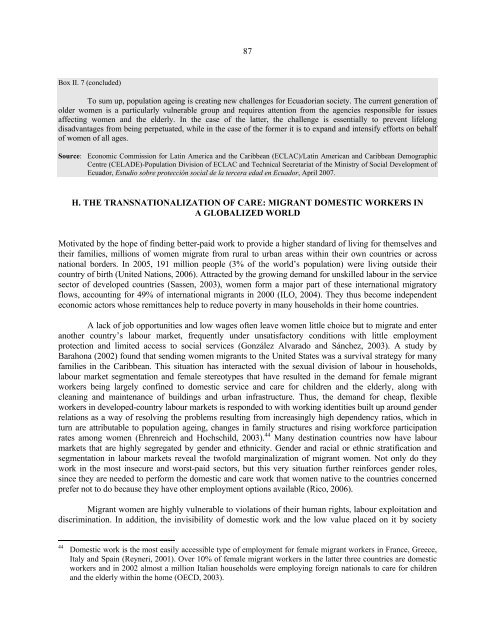Women in Latin America and the Caribbean - Cepal
Women in Latin America and the Caribbean - Cepal
Women in Latin America and the Caribbean - Cepal
You also want an ePaper? Increase the reach of your titles
YUMPU automatically turns print PDFs into web optimized ePapers that Google loves.
87<br />
Box II. 7 (concluded)<br />
To sum up, population age<strong>in</strong>g is creat<strong>in</strong>g new challenges for Ecuadorian society. The current generation of<br />
older women is a particularly vulnerable group <strong>and</strong> requires attention from <strong>the</strong> agencies responsible for issues<br />
affect<strong>in</strong>g women <strong>and</strong> <strong>the</strong> elderly. In <strong>the</strong> case of <strong>the</strong> latter, <strong>the</strong> challenge is essentially to prevent lifelong<br />
disadvantages from be<strong>in</strong>g perpetuated, while <strong>in</strong> <strong>the</strong> case of <strong>the</strong> former it is to exp<strong>and</strong> <strong>and</strong> <strong>in</strong>tensify efforts on behalf<br />
of women of all ages.<br />
Source: Economic Commission for Lat<strong>in</strong> <strong>America</strong> <strong>and</strong> <strong>the</strong> <strong>Caribbean</strong> (ECLAC)/Lat<strong>in</strong> <strong>America</strong>n <strong>and</strong> <strong>Caribbean</strong> Demographic<br />
Centre (CELADE)-Population Division of ECLAC <strong>and</strong> Technical Secretariat of <strong>the</strong> M<strong>in</strong>istry of Social Development of<br />
Ecuador, Estudio sobre protección social de la tercera edad en Ecuador, April 2007.<br />
H. THE TRANSNATIONALIZATION OF CARE: MIGRANT DOMESTIC WORKERS IN<br />
A GLOBALIZED WORLD<br />
Motivated by <strong>the</strong> hope of f<strong>in</strong>d<strong>in</strong>g better-paid work to provide a higher st<strong>and</strong>ard of liv<strong>in</strong>g for <strong>the</strong>mselves <strong>and</strong><br />
<strong>the</strong>ir families, millions of women migrate from rural to urban areas with<strong>in</strong> <strong>the</strong>ir own countries or across<br />
national borders. In 2005, 191 million people (3% of <strong>the</strong> world’s population) were liv<strong>in</strong>g outside <strong>the</strong>ir<br />
country of birth (United Nations, 2006). Attracted by <strong>the</strong> grow<strong>in</strong>g dem<strong>and</strong> for unskilled labour <strong>in</strong> <strong>the</strong> service<br />
sector of developed countries (Sassen, 2003), women form a major part of <strong>the</strong>se <strong>in</strong>ternational migratory<br />
flows, account<strong>in</strong>g for 49% of <strong>in</strong>ternational migrants <strong>in</strong> 2000 (ILO, 2004). They thus become <strong>in</strong>dependent<br />
economic actors whose remittances help to reduce poverty <strong>in</strong> many households <strong>in</strong> <strong>the</strong>ir home countries.<br />
A lack of job opportunities <strong>and</strong> low wages often leave women little choice but to migrate <strong>and</strong> enter<br />
ano<strong>the</strong>r country’s labour market, frequently under unsatisfactory conditions with little employment<br />
protection <strong>and</strong> limited access to social services (González Alvarado <strong>and</strong> Sánchez, 2003). A study by<br />
Barahona (2002) found that send<strong>in</strong>g women migrants to <strong>the</strong> United States was a survival strategy for many<br />
families <strong>in</strong> <strong>the</strong> <strong>Caribbean</strong>. This situation has <strong>in</strong>teracted with <strong>the</strong> sexual division of labour <strong>in</strong> households,<br />
labour market segmentation <strong>and</strong> female stereotypes that have resulted <strong>in</strong> <strong>the</strong> dem<strong>and</strong> for female migrant<br />
workers be<strong>in</strong>g largely conf<strong>in</strong>ed to domestic service <strong>and</strong> care for children <strong>and</strong> <strong>the</strong> elderly, along with<br />
clean<strong>in</strong>g <strong>and</strong> ma<strong>in</strong>tenance of build<strong>in</strong>gs <strong>and</strong> urban <strong>in</strong>frastructure. Thus, <strong>the</strong> dem<strong>and</strong> for cheap, flexible<br />
workers <strong>in</strong> developed-country labour markets is responded to with work<strong>in</strong>g identities built up around gender<br />
relations as a way of resolv<strong>in</strong>g <strong>the</strong> problems result<strong>in</strong>g from <strong>in</strong>creas<strong>in</strong>gly high dependency ratios, which <strong>in</strong><br />
turn are attributable to population age<strong>in</strong>g, changes <strong>in</strong> family structures <strong>and</strong> ris<strong>in</strong>g workforce participation<br />
rates among women (Ehrenreich <strong>and</strong> Hochschild, 2003). 44 Many dest<strong>in</strong>ation countries now have labour<br />
markets that are highly segregated by gender <strong>and</strong> ethnicity. Gender <strong>and</strong> racial or ethnic stratification <strong>and</strong><br />
segmentation <strong>in</strong> labour markets reveal <strong>the</strong> twofold marg<strong>in</strong>alization of migrant women. Not only do <strong>the</strong>y<br />
work <strong>in</strong> <strong>the</strong> most <strong>in</strong>secure <strong>and</strong> worst-paid sectors, but this very situation fur<strong>the</strong>r re<strong>in</strong>forces gender roles,<br />
s<strong>in</strong>ce <strong>the</strong>y are needed to perform <strong>the</strong> domestic <strong>and</strong> care work that women native to <strong>the</strong> countries concerned<br />
prefer not to do because <strong>the</strong>y have o<strong>the</strong>r employment options available (Rico, 2006).<br />
Migrant women are highly vulnerable to violations of <strong>the</strong>ir human rights, labour exploitation <strong>and</strong><br />
discrim<strong>in</strong>ation. In addition, <strong>the</strong> <strong>in</strong>visibility of domestic work <strong>and</strong> <strong>the</strong> low value placed on it by society<br />
44<br />
Domestic work is <strong>the</strong> most easily accessible type of employment for female migrant workers <strong>in</strong> France, Greece,<br />
Italy <strong>and</strong> Spa<strong>in</strong> (Reyneri, 2001). Over 10% of female migrant workers <strong>in</strong> <strong>the</strong> latter three countries are domestic<br />
workers <strong>and</strong> <strong>in</strong> 2002 almost a million Italian households were employ<strong>in</strong>g foreign nationals to care for children<br />
<strong>and</strong> <strong>the</strong> elderly with<strong>in</strong> <strong>the</strong> home (OECD, 2003).











